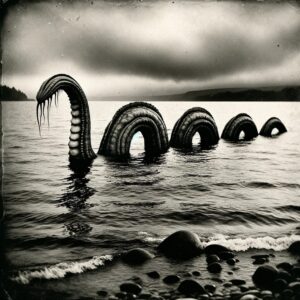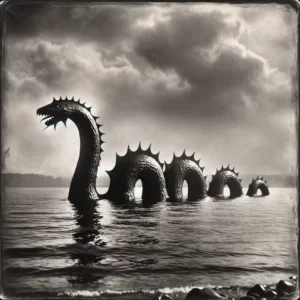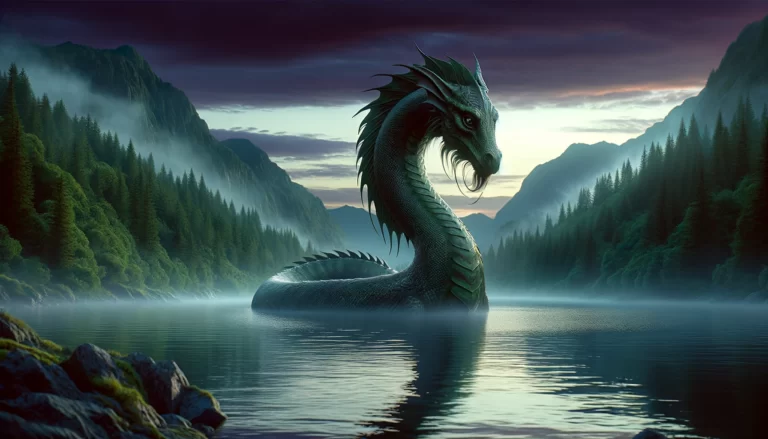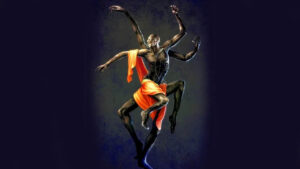Table of Contents
Deep within the pristine waters of Okanagan Lake, nestled amidst the picturesque landscapes of British Columbia, Canada, lurks a creature of myth and legend, known as Ogopogo. This elusive and enigmatic water-dwelling being has captured the imaginations of locals and intrigued the world for centuries. With its long history, numerous sightings, and enduring mysteries, Ogopogo is a fascinating addition to the pantheon of mythical creatures.
Origins and Cultural Significance
Physical Appearance

Eyewitness accounts and reported sightings consistently describe Ogopogo with several distinct features. People typically portray it as a serpentine creature with a long, sinuous body that undulates through the water, often likening it to a large sea serpent or prehistoric plesiosaur. The most prominent feature is its long, slender neck, which frequently extends several feet above the water’s surface. Some observers mention a horse-like head, while others note a more reptilian appearance, often with a humpbacked profile. Its skin is typically described as dark, with shades of green or black and a scaly or ridged texture. The creature’s size remains a topic of debate, with estimates ranging from 20 to 50 feet in length, a variation attributed to the different perspectives of witnesses and the challenges of accurately gauging the size of a submerged creature from a distance.
Abilities and Behavior
The mysterious nature of Ogopogo extends beyond its appearance to its behavior and abilities. While there is limited concrete evidence, numerous reports suggest that Ogopogo is a powerful and elusive creature. Eyewitness accounts often describe it as swift and agile, capable of moving swiftly through the water.
Believers think that Ogopogo is primarily an aquatic creature, seldom venturing onto land. Its preferred habitat consists of the deep waters of Okanagan Lake, where it is believed to dwell in underwater caves or concealed crevices. Some witnesses claim to have seen the creature breaching the surface briefly before disappearing beneath the waves, leaving behind only ripples and waves as evidence of its presence.
Symbols and Legends
Moreover, Ogopogo has become an enduring symbol of the Okanagan Valley and has left an indelible mark on the region’s culture and identity. It has inspired numerous local legends, stories, and artwork, cementing its place in the collective imagination of the community.
Furthermore, in 1989, the city of Kelowna, located on the shores of Okanagan Lake, officially adopted Ogopogo as its mascot. Various local emblems and tourist attractions feature the likeness of the creature, solidifying its status as a beloved and iconic figure in the region.
Sightings and Stories
Countless reported sightings of Ogopogo over the years have contributed to the mystique and intrigue surrounding this mythical creature. While many sightings are anecdotal and lack concrete evidence, they contribute to the rich tapestry of Ogopogo lore.
One of the earliest documented sightings dates back to 1872 when a group of settlers reported seeing a strange creature in the lake. Since then, sightings have continued to be reported, with some being captured on film or in photographs. However, due to the elusive nature of Ogopogo and the limitations of photographic technology, these images often remain inconclusive.
In 1968, Art Folden, a respected local resident, managed to capture a series of photographs that garnered significant attention. The images showed a dark, serpentine shape breaking the water’s surface, lending some credibility to the existence of Ogopogo. Still, skeptics argued that the images could depict a variety of natural phenomena or objects.
Scientific and Skeptical Explanations

The existence of Ogopogo has long been a topic of debate among scientists, skeptics, and cryptozoologists. While the legend of Ogopogo has persisted for centuries, the lack of conclusive evidence has led many to dismiss it as a mere legend or optical illusion.
Skeptics offer various explanations for Ogopogo sightings, including misidentifications of logs, debris, or other natural phenomena, as well as the play of light and shadow on the water’s surface. Some contend that the power of suggestion or a desire to believe in the existence of a mysterious creature might influence the reports.
On the other hand, proponents of Ogopogo’s existence point to the consistency of eyewitness accounts, the long history of sightings, and the possibility that a large, undiscovered aquatic creature could inhabit the depths of Okanagan Lake. They argue that the creature’s elusive nature and the vastness of the lake make it challenging to obtain definitive proof.
Ongoing Investigations
The quest to uncover the truth behind Ogopogo’s existence continues to this day. In recent years, advancements in technology have allowed for more sophisticated searches and investigations of Okanagan Lake. Efforts to capture evidence of the creature have utilized underwater drones, sonar equipment, and high-resolution imaging.
In 2018, a team of researchers conducted a comprehensive scientific study of Okanagan Lake, using DNA analysis to survey the aquatic life present. While the study did not yield any conclusive evidence of Ogopogo, it did shed light on the lake’s diverse ecosystem and the possibility of undiscovered species.
Similar cultures
Several mythical creatures from various cultures share similar abilities or appearances with Ogopogo, often involving lake or sea monsters. Some of these include:
Nessie, the Loch Ness Monster: People believe that Nessie inhabits Loch Ness in Scotland. Like Ogopogo, eyewitnesses describe it as a long-necked, serpentine creature residing in deep waters.
Champ: Legends claim that Champ dwells in Lake Champlain, mainly in the United States and Canada. It’s a large, serpent-like creature often characterized by humps.
Lake Storsjön in Sweden is thought to be home to a long-necked aquatic monster known as the Great Lake Monster (Storsjöodjuret).
Legends depict Morag as a large, serpent-like creature believed to inhabit Loch Morar in Scotland.
Similar to Ogopogo, people believe that Manipogo exists in Lake Manitoba in Canada as a long, serpent-like creature.
FAQ
What does Ogopogo look like?
Ogopogo is typically described as a serpentine creature with a long neck, often compared to a sea serpent or plesiosaur. Its skin is said to be dark and scaly.
Is Ogopogo real?
There is no scientific evidence to confirm the existence of Ogopogo. It is considered a cryptid or mythical creature.
Where did the name Ogopogo come from?
The modern name "Ogopogo" is believed to have been coined by English settlers in the late 19th century, inspired by a music-hall song called "The Ogo-Pogo: The Funny Foxtrot."
Are there any efforts to find Ogopogo?
Over the years, there have been efforts to search for Ogopogo using underwater technology and sonar equipment, but no conclusive evidence has been found.
What is Ogopogo's cultural significance?
Ogopogo is an iconic figure in the Okanagan Valley, inspiring local legends, stories, and artwork. It is also featured in emblems and tourist attractions in the region.




